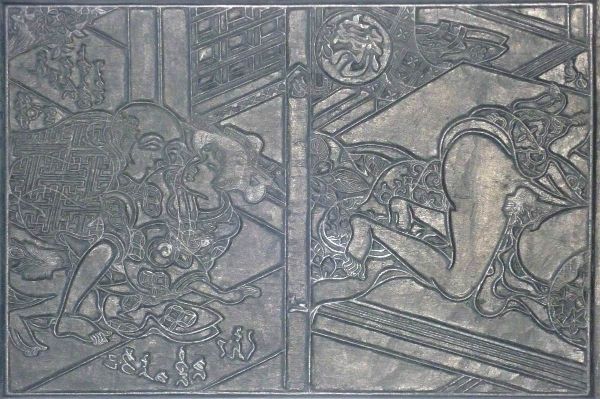A Twist of Figured Cloth – Shunga wood blocks
This is the first of an occasional blog that I hope clients will find interesting.
In the current update is an important and rare set of six original wood blocks for a shunga (erotic) book Aya no odamaki “A Twist of Figured Cloth” by Terasawa Masatsugu (active c1760-1790) published in 1776 in black and white, so these are the key-blocks (or sumi-blocks) which constitute reversed or mirror-images of the book.
It is pure serendipity that a few original blocks have survived. Many were planed down to recut as wood became more expensive during the 19th century and a lot more were probably used for kindling or destroyed by fire. There is also an apocryphal story that the Victoria and Albert Museum, here in London, burnt a large number of blocks after the Second World War to free up storage space. Early blocks, such as these, are particularly rare. Blocks that survive with big names attached – Harunobu or Hiroshige, for example, are invariably for copies. Shunga blocks are of added rarity. Indeed, this is the only set I have seen . The blocks have a great beauty in their own right and are from the wood of the single-petaled white mountain cherry (shiro-yamasakura or Prunus mutabilis).

During the Edo period outlines were cut following the direction of the brush strokes of the original drawing, the knife being drawn towards the block-cutter. The block- cutter followed the drawing (hanshita-e) which was pasted face downward onto the block and partially peeled or rubbed with hempseed oil to render it more visible. Cutting was deeper in the 18th century and became shallower during the 19th, probably due to the cost of wood and the gradual sophistication of the cutters. In Japan wood was cut with the grain; this method is fundamentally similar to western chiaroscuro woodcuts, hence the operation is one of relief printing as opposed to intaglio. The impression from the grain of the wood-block was transferred to the paper during printing and is visible on early impressions – an infallible way of recognising genuine impressions rather than copies.
Colour prints used proofs from the key-block to make the colour blocks and were keyed by the simple expedient of marks (notches) cut in the block on the upper and lower left corners. Cutting of a set of blocks could take two or three days while complicated sets were finished within twenty days.
The blocks are priced separately to give as many collectors as possible the opportunity to acquire one, and would sit well with any serious collection of prints, books or shunga.